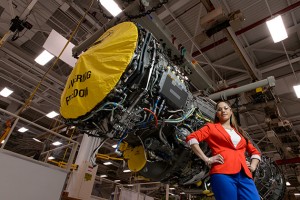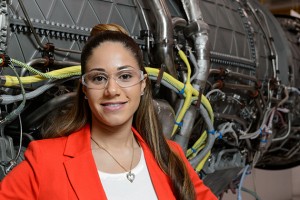Astronomy. Computer science. Chemistry. Advanced education in these and other fields of science, technology, engineering, and mathematics – collectively known as STEM – has perhaps never been in greater demand. Over the past decade, jobs in STEM disciplines have grown three times faster than non-STEM jobs, and STEM workers are earning 26 percent more than their non-STEM counterparts, according to the U.S. Department of Commerce’s Economics and Statistics Administration.
Yet the supply of qualified STEM workers remains a concern for U.S. businesses and for the country as a whole. While President Barack Obama has pronounced graduating 1 million additional STEM graduates over the next decade a national priority, fewer than 40 percent of students who currently enter college intending to major in a STEM field actually receive a STEM degree.
UConn, with the state of Connecticut, aims to change this. Early this year, Connecticut Gov. Dannel P. Malloy and UConn President Susan Herbst unveiled an ambitious new proposal designed to expand educational opportunities, research, and innovation specifically in STEM across the University.

 Melissa Jacques ’10 (ENG), project engineer at Pratt & Whitney, is getting some of the world’s most powerful military jets up to speed. See sidebar below for her story. (Peter Morenus/UConn Photo)
Melissa Jacques ’10 (ENG), project engineer at Pratt & Whitney, is getting some of the world’s most powerful military jets up to speed. See sidebar below for her story. (Peter Morenus/UConn Photo)‘Time to act’
The $1.5 billion initiative, called Next Generation Connecticut, calls for greater numbers of STEM faculty, an increase in the number of enrolled students in the STEM fields, the establishment of the nation’s first honors program specifically for high-achieving STEM students, and renovations to appropriate campus facilities. In addition to helping propel UConn forward in the areas of high-tech research and academics, the proposal is intended to enhance the state’s economic development efforts for decades to come – in the form of new jobs, companies, and research advances.
“It is now Connecticut’s time to act. We want to catch up to great states and leap ahead in key areas such as genomics, materials science, cognitive neuroscience, marine science, and digital media,” Herbst said at a hearing held in March at the state Capitol in Hartford. “Next Generation Connecticut will make that happen, and this initiative will finally enable us to reach the top. Connecticut deserves to have a great top public research university that leads scientific discovery.”
Specifics of the plan include the following:
- Increasing total enrollment by 30 percent. Of those, almost 3,300 would be STEM students, including 70 percent more engineering students.
- Revolutionizing STEM infrastructure at the Storrs campus by building facilities to house materials science, biology, engineering, physics, and related disciplines. Aging infrastructure would also be updated to accommodate new faculty and students.
- Creating the nation’s premier STEM honors program.
- Hiring 259 new faculty members in addition to the 290 already in the current faculty hiring plan. Of the 259 additional new faculty hires, 200 would be dedicated specifically to STEM programs.
“To make the most of this economic opportunity, Connecticut needs highly skilled, highly qualified men and women to be the STEM workforce of the future – and the University of Connecticut will produce the graduates who will be that workforce,” Herbst says. “They will live here, work here, and help make Connecticut the intellectual and economic success story it must be in the future.”
The proposal requires the endorsements of a variety of legislative committees before it can advance to the full General Assembly for consideration. The legislature adjourns on June 5.
Check out UConn’s Next Generation Connecticut video at s.uconn.edu/nextgen, and follow the conversation via social media with the hashtag #NextGenCT.

High-Powered Performance
UConn Engineering Alum’s Career Taking Off in STEM
As a little girl, Melissa Jacques ’10 (ENG) recalls watching with fascination whenever her father spent time fixing household gadgets.
“He’d sit at the kitchen table, take things apart, analyze them, and repair them,” she says. “Sometimes I’d see him taking notes and deriving calculations to troubleshoot a problem.”
Jacques has since taken this early fascination to a whole new level, today serving as a project engineer at Pratt & Whitney, a leading aerospace manufacturer based in Connecticut. There, she works on the tooling used to assemble and disassemble military jet engines that are among the world’s most powerful and advanced of their kind – built for the F-35 Lightning II jet, an aircraft designed for use by the Navy, Air Force, and Marines.
On a recent trip to an Air Force base, Jacques saw her work in action firsthand, witnessing the flight of the aircraft powered by the engine she supports. With a younger brother in the Marines, Jacques says that what she does for a living – working with military jet engines – has special significance.
“I feel even more pride in providing technology to the customer because of that personal connection,” she says.
As an engineer, and a female one at that, Jacques stands at the forefront of a field poised for particularly positive developments. Jobs in the STEM fields are predicted to grow by 17 percent through 2018 as compared to 10 percent in non-STEM fields, according to the U.S. Bureau of Labor Statistics. It is also an area in which far fewer women than men currently hold undergraduate degrees; for example, only one of every seven engineers is female.
A double major at UConn in materials science and engineering and mechanical engineering, Jacques served as president of the UConn chapter of the National Society of Black Engineers and spent college summers and winters holding numerous internships. A four-time intern at United Technologies Hamilton Sundstrand, now United Technologies Aerospace Systems, she honed the kinds of skills she would need in the industry – for instance, offering insights into the environmental controls for the presidential helicopter.
For Jacques, who plans to earn an MBA, serve as a certified project management professional, and continue to work at Pratt & Whitney, there is – perhaps quite literally – nowhere for her to go but up.
—Karen Cohen




